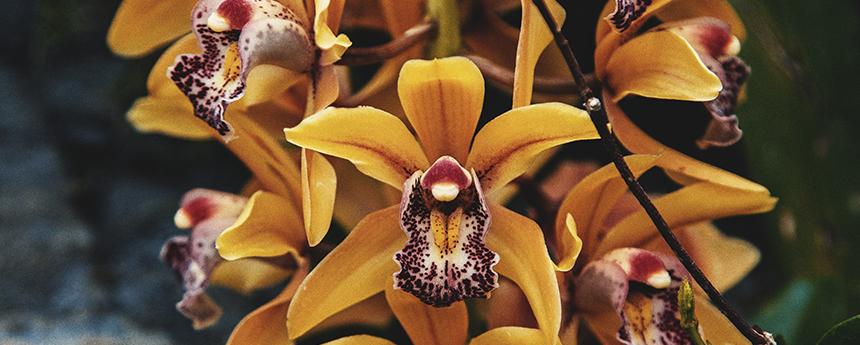- 2023-01-06
Cymbidium Maintenance guide
Growth habit:
Like Yin, afraid of direct sunlight; Like wet, bogey dry; Preferring fertility and abundant humus; Good air circulation environment.
Cultivation technique:
1,Divide the pot
After the pot is full, the pot is divided, usually once every 2 to 3 years, in March to early April (autumn orchid), or October to mid-November (summer orchid, spring orchid). When dividing POTS, the soil should be dry. If it is wet mud, it is inconvenient to operate and easy to break the root. After the mother plant is turned out, gently remove the mud, and then wipe it according to the natural plant. Trim the dead roots and leaves. Be careful not to touch the leaf buds and fleshy roots. Then wash the roots with clean water, put in the shade, until the root color is white, dry, can be separated on the basin. Such as the weather is getting wet, but also must first in the sun exposure for about 10 minutes, favorable orchid growth.
2, on the basin
Flowerpot with small mouth, deep pot, bottom hole is better. The new wild seedlings dug from the mountains must be planted in earthen POTS, which can be changed into purple sand POTS or porcelain POTS after 2~3 years. First cover the bottom hole of the basin with clam shell, brown pieces, etc., and add coarse sand, coal cinder and charcoal to form steamed buns, accounting for about 1/3 of the capacity. The top culture soil is about 3~5 cm thick. Generally do not add base fertilizer. Then put the orchid into the pot, the root dense row, add good mix of fine soil to 2~3 cm away from the pot, the orchid slightly lifted, the height of the upper end of the false bulb and the soil level, not too shallow or too deep. Press the soil lightly, so that the soil is in close contact with the roots, and then use your fingers to compact around the basin, so as not to create holes when watering. If the top layer of a layer of moss or broken tiles, watering is not easy to cause hardening, and can reduce water evaporation. The first watering using sitting basin method, so that the basin absorbs enough water. Finally, put the pot orchid in a shady place for about half a month to 1 month. This time must control watering, not too wet. After placed in the half shade half sun, breathable, can shine to the sun in the morning. The basin platform should be about 1 meter high and cannot be placed on the platform to prevent ants and earthworms from entering the bottom hole of the basin and affecting the growth of orchids. Culture soil can be the first layer of hillside soil, or with fine sand and loam 3:7 plus humus compost 30% mix. Culture soil should be screened and sterilized before use.

3. Fertilization
It is not enough to do without, and it is not enough to do more or more. If a new orchid is put into a pot, the soil in the pot is too fat, it often does not survive, and even if it does survive, it rarely flowers. If summer fertilizer is too much, the autumn leaves tend to flourish, often resulting in poor leaf bloom in spring. If autumn fertilizer is too little, it will affect the formation of underground flower buds at the turn of autumn and winter. If nitrogen fertilizer is too much, the leaves are too fat, so that the growth of the leaves and flowers of malnutrition, there will be no flowering or less flowering phenomenon. In general, small amounts of nitrogen can be applied several times when the buds are newly emerging. The vernal and autumn equinoxes and about 20 days after the fall of flowers are appropriate times. Fertilization time in the evening is the best, the second day in the morning to pour water again. Apply once every 2-3 weeks. At the same time, spray potassium dihydrogen phosphate once every 20 days to promote the flowering of pregnant buds. According to leaf color fertilization, is a better way, yellow and thin leaf is lack of fertilizer, should be topdressing, black and leaf tip hair coke is too much fertilizer, should stop fertilization. Fertilizer must be decomposed, not decomposed can not be used, avoid using human excrement.
4. Water
Practice has proved that orchid eight dry, two wet is the best, flowering and germination stage, watering less. During the rainy season, you should move back indoors or put up a shelter to protect yourself from the rain. Summer in the early morning or evening watering, should not be too much, the amount of autumn watering can be increased. Spray every evening in the dry season. When spraying upward, the mist point is fine and even, so that the leaf surface is moist, the ground is moist, and the air humidity is increased. Sometimes it is better to spray it several times a day, but water it from the edge of the basin; do not pour it over the head; do not pour it at noon. Winter watering can be greatly reduced, but not not pouring, pay attention to not let the basin soil dry, winter and early spring and watering caused the leaves along the wet leaf sheath, to be dried after moving into the room, so as not to rot. In short, dry is pouring, wet is stopped, appropriate partial dry for the principle. Water to rain, spring water is good, all kinds of water should be taken first to save in the tank, so that the water pollutants precipitation, normal water temperature, so that the chlorine gas escape in tap water, and then pouring.
5. Light
Light is an important factor in the formation of flower buds. Orchids, though cool, rarely bloom if they are kept in hiding all year round. Orchid practitioners have long found that the mountain orchid has long leaves and sparse flowers, while the mountain orchid has short leaves and many flowers. So cultivating orchids must pay attention to the problem of illumination. In spring and summer, orchids are best shaded by reed curtains, or placed in indoor Windows facing east to south wind. Under the curtain, orchids should be turned once every half month, so that orchids are exposed to light on all sides, which is conducive to balanced growth of plants. When it is cool in autumn, the pot orchid should be removed from the shade and let it bask in the morning sun, but pay attention to the autumn dry. Cold days put indoor under the south window winter, but not too warm, the best covered plastic film cover, in order to maintain the appropriate humidity leaf surface. As for pest control, such as brown rust, white silk disease, with 0.5% stone sulfur mixture treatment. If there is an ant nest, the basin can be submerged in water to drive it away.
6. Place
The location of orchids is very important, it directly affects the growth and development of orchids. Orchids are generally kept in the open in spring, summer and autumn (in the shade of the open in summer) and indoors in winter. It's best to be outside with open space and moist air. The room should have plenty of light, preferably facing south. In this way, favorable orchid growth. The orchid pot is best placed on a wooden frame or table, not on the ground.

7. Shade
Orchids belong to semi-feminine plants, most species are afraid of direct sunlight, need appropriate shade. Orchids in the middle of April, can be more sunlight to promote their growth. Proper shade after late April. The upright leaf varieties of summer orchid and autumn orchid are best placed in the south of the shade, so that they are properly exposed to the sun; Autumn orchid and Cymbidium pendulatum, two hours of light every day is good. From June to September, every day to early shade, such as reed curtain can be used with a dense curtain or two layers of thin curtain. After October, the weather turns cool and the sun is weak, so we can postpone the shading, but we still need to pay attention to the shading work before and after noon.
8. Prevent rain
Orchid can be drizzled, but to avoid mildew, showers or continuous rain. In the season of mildew and rain, it is especially necessary to do a good job of rain prevention. From late June to mid-September, showers are common. If the rain time is short, and the rainfall is small, in the evening should be more watering, so that the pot heat discharge, otherwise it will make the orchid damage, even rot and die. If the shower followed by the sun, need to timely shade, so as not to affect the growth of orchids. Rainy season, is the orchid extraction stage of leaf buds, such as pot soil is too warm will cause leaf buds growth is not good or cause disease. At this time, can scatter a small amount of grass and wood ash, in order to adjust the basin soil humidity.




















